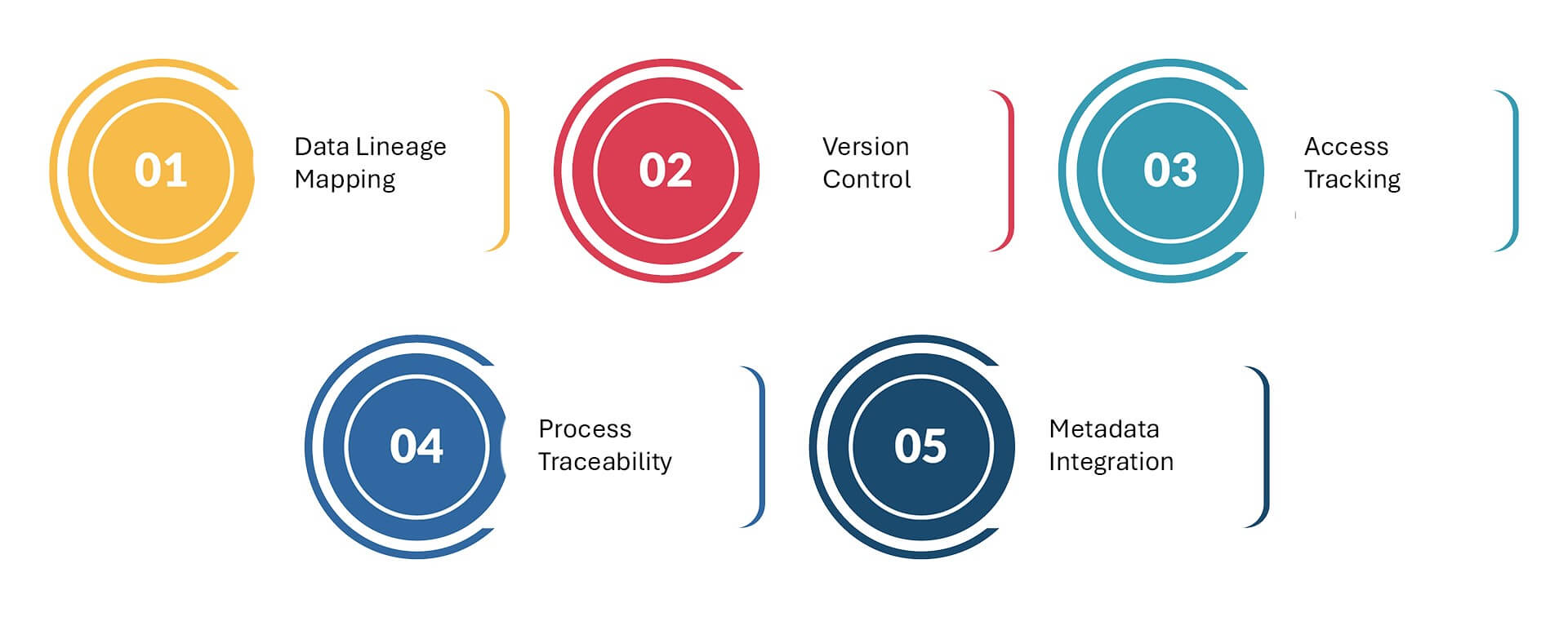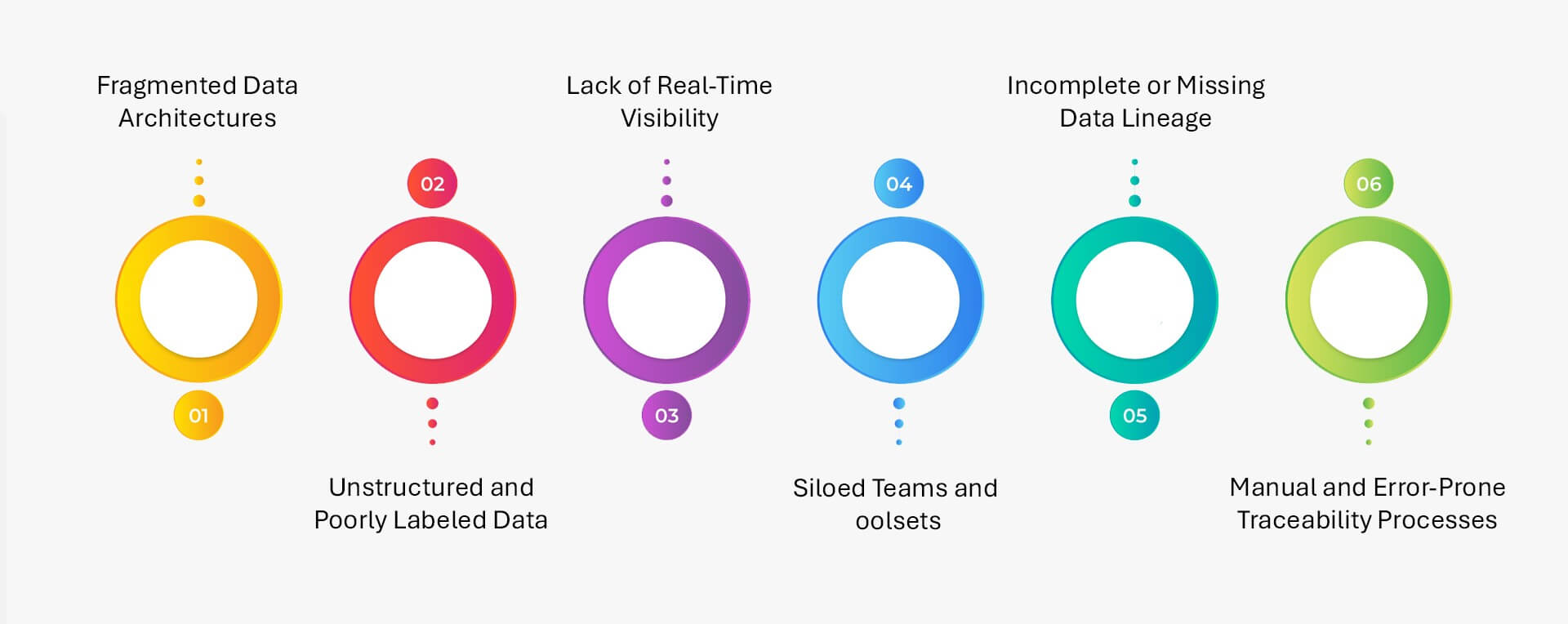What is Data Traceability?
Data traceability refers to the ability to track the flow, transformations, and usage of data across its entire lifecycle—from its origin to every system, user, or process it touches. It enables organizations to answer critical questions: Where did this data come from? How has it changed? Who accessed it? And why?
Think of it as the audit trail for data—mapping its lineage, validating its integrity, and ensuring accountability at every step.
Why Data Traceability Matters
In a world governed by AI, automation, and data-driven decision-making, trust in data is non-negotiable. Yet without traceability, even the most advanced analytics or AI models operate in a black box, leaving enterprises vulnerable to poor outcomes, regulatory penalties, and reputational risk.
From complying with regulations like GDPR, HIPAA, and India’s DPDP Act to training ethical AI systems, data traceability is no longer a nice-to-have—it’s foundational to governance, security, and operational excellence.
According to IDC, organizations that fail to implement traceable data processes are twice as likely to suffer compliance violations or data quality failures in AI-driven environments.
Key Capabilities of Data Traceability

- Data Lineage Mapping: Visualizing the journey of data from ingestion through pipelines, transformations, and final outputs.
- Version Control: Recording changes in datasets over time—who modified what, when, and why.
- Access Tracking: Logging user interactions and system access to ensure role-based control and accountability.
- Process Traceability: Linking data to the business processes and workflows it influences or supports.
- Metadata Integration: Capturing descriptive, structural, and administrative metadata for better context and classification.
Where Traceability Delivers Real Impact
- Regulatory Compliance: Proving data provenance and handling in audits and SARs (Subject Access Requests).
- AI and Model Governance: Ensuring that training data is trustworthy, explainable, and auditable.
- Data Quality Assurance: Identifying the root cause of errors by tracing the path of data upstream.
- Security Incident Response: Investigating how sensitive data was accessed, moved, or modified after a breach.
- Supply Chain and IoT: Tracking sensor data or supplier information across edge systems and global operations.
Challenges in Data Traceability – and What to Do About Them

Fragmented Data Architectures
Data flows across multiple environments—on-prem, multi-cloud, SaaS, and edge systems—making end-to-end traceability difficult and inconsistent.
What to do: Implement a centralized data observability framework that can integrate with all data sources through APIs and connectors. Use standardized metadata models to unify visibility across platforms and pipelines.
Unstructured and Poorly Labeled Data
The majority of enterprise data is unstructured and lacks clear classification, making it hard to trace origin, usage, or ownership.
What to do: Deploy AI-powered discovery and tagging tools that automatically identify personal, sensitive, or high-value data. Enforce policy-based classification and associate data with ownership metadata for accountability.
Lack of Real-Time Visibility
Static or delayed traceability limits the ability to respond to anomalies, policy violations, or model drift in AI pipelines.
What to do: Adopt real-time monitoring tools that can track data lineage, changes, and access patterns continuously. Use event-driven alerts and automation for faster remediation and compliance response.
Siloed Teams and Toolsets
Data engineering, governance, and compliance teams often use disconnected systems—leading to fragmented visibility and inconsistent traceability documentation.
What to do: Break silos with a unified data governance platform that provides role-based access to lineage maps and audit trails. Establish shared ownership of traceability metrics across departments.
Incomplete or Missing Data Lineage
Many legacy systems or third-party data sources don’t track lineage natively, leading to blind spots in how data moves or transforms across systems.
What to do: Use reverse-engineering tools and metadata crawlers to reconstruct lineage where native tracking is unavailable. Supplement with manual lineage documentation for critical systems and integrate into your central data catalog.
Manual and Error-Prone Traceability Processes
Relying on spreadsheets, documentation, or tribal knowledge to track data flow increases the risk of errors and makes traceability non-repeatable.
What to do: Automate lineage capture and traceability mapping through data pipeline instrumentation and ETL tool integration. Schedule continuous scans to detect changes and flag anomalies in data movement or transformation logic.
Why Data Traceability Will Define the Next Decade of AI, Compliance, and Digital Trust
In an era where AI decisions shape credit approvals, medical diagnoses, and hiring outcomes, data traceability is no longer a backend feature—it’s a public expectation and regulatory necessity. It provides the transparency required to trust automated outcomes, the auditability required to meet compliance obligations, and the control needed to govern data across complex digital ecosystems.
As AI adoption accelerates, traceability ensures not only that we understand what a model predicted, but why it made that decision—and what data influenced it. Without traceability, AI becomes a black box. With it, AI becomes explainable, ethical, and legally defensible.
From a compliance standpoint, regulations are shifting from static mandates to dynamic accountability. The GDPR, India’s DPDP Act, and the EU AI Act are increasingly demanding demonstrable lineage, real-time auditability, and contextual data tracking. Enterprises must now show how data is sourced, transformed, and accessed—in real time, not retroactively. Traceability becomes the proof point that privacy and governance aren’t theoretical—they’re operationalized.
But perhaps the most critical role traceability plays is in shaping digital trust. In a world where misinformation, data misuse, and algorithmic bias erode public confidence, organizations that can demonstrate full traceability of their data, from origin to output, will lead. They’ll be the ones regulators trust, customers choose, and partners rely on.
Looking ahead, data traceability will underpin everything from AI model certification and bias detection to real-time incident response and zero-trust architectures. It’s not just a governance requirement—it’s the infrastructure for responsible innovation.
Because in the next decade, success won’t hinge on how much data you have—it will depend on how well you can trace, trust, and act on it.
Data traceability isn’t just a feature—it’s a framework for building trustworthy, secure, and intelligent enterprises. In a digital world where algorithms act autonomously and regulations evolve constantly, knowing where your data has been, how it got there, and who touched it is no longer optional.
It’s how you turn data into a governed asset, not a growing liability.
Because if you can’t trace your data, you can’t trust your outcomes.
Getting Started with Data Dynamics:
- Learn about Unstructured Data Management
- Schedule a demo with our team
- Read the latest blog: How Data Sovereignty Is Challenging Data Governance — And What the Future Demands






